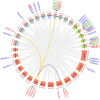Genome-wide identification of the glutamate receptor-like gene family in Vanilla planifolia and their response to Fusarium oxysporum infection
- PMID: 37096589
- PMCID: PMC10132242
- DOI: 10.1080/15592324.2023.2204654
Genome-wide identification of the glutamate receptor-like gene family in Vanilla planifolia and their response to Fusarium oxysporum infection
Abstract
Glutamate receptor-like genes (GLRs) are essential for plant growth and development and for coping with environmental (biological and non-biological) stresses. In this study, 13 GLR members were identified in the Vanilla planifolia genome and attributed to two subgroups (Clade I and Clade III) based on their physical relationships. Cis-acting element analysis and Gene Ontology (GO) and Kyoto Encyclopedia of Genes and Genomes (KEGG) annotations indicated the GLR gene regulation's complexity and their functional diversity. Expression analysis revealed a relatively higher and more general expression pattern of Clade III members compared to the Clade I subgroup in tissues. Most GLRs showed significant differences in expression during Fusarium oxysporum infection. This suggested that GLRs play a critical role in the response of V. planifolia to pathogenic infection. These results provide helpful information for further functional research and crop improvement of VpGLRs.
Keywords: Fusarium oxysporum; Vanilla planifolia; biotic stress; expression pattern; glutamate receptor-like genes.
Conflict of interest statement
No potential conflict of interest was reported by the authors.
Figures







Similar articles
-
Genome-wide identification of glutamate receptor-like gene family in soybean.Heliyon. 2023 Oct 30;9(11):e21655. doi: 10.1016/j.heliyon.2023.e21655. eCollection 2023 Nov. Heliyon. 2023. PMID: 38027661 Free PMC article.
-
Functional categorization of de novo transcriptome assembly of Vanilla planifolia Jacks. potentially points to a translational regulation during early stages of infection by Fusarium oxysporum f. sp. vanillae.BMC Genomics. 2019 Nov 8;20(1):826. doi: 10.1186/s12864-019-6229-5. BMC Genomics. 2019. PMID: 31703622 Free PMC article.
-
Genome-wide identification and expression analysis of glutamate receptor-like genes in three Dendrobium species.Biochim Biophys Acta Gen Subj. 2025 May;1869(6):130789. doi: 10.1016/j.bbagen.2025.130789. Epub 2025 Mar 7. Biochim Biophys Acta Gen Subj. 2025. PMID: 40058613
-
Structural and Functional Diversity of Glutamate Receptors-Like Channels in Plants.Physiol Plant. 2025 May-Jun;177(3):e70313. doi: 10.1111/ppl.70313. Physiol Plant. 2025. PMID: 40468591 Review.
-
Glutamate receptor like channels: Emerging players in calcium mediated signaling in plants.Int J Biol Macromol. 2023 Apr 15;234:123522. doi: 10.1016/j.ijbiomac.2023.123522. Epub 2023 Feb 8. Int J Biol Macromol. 2023. PMID: 36758765 Review.
Cited by
-
Genome-Wide Identification and Expression Analysis of Phytosulfokine Peptide Hormone Genes in Camellia sinensis.Int J Mol Sci. 2025 Mar 7;26(6):2418. doi: 10.3390/ijms26062418. Int J Mol Sci. 2025. PMID: 40141062 Free PMC article.
-
Evolutionary and functional differentiation of the glutamate receptor-like family in tea (Camellia sinensis) plants and other plants.Funct Integr Genomics. 2025 Sep 11;25(1):190. doi: 10.1007/s10142-025-01696-w. Funct Integr Genomics. 2025. PMID: 40932537
-
Genome-wide identification of glutamate receptor-like gene family in soybean.Heliyon. 2023 Oct 30;9(11):e21655. doi: 10.1016/j.heliyon.2023.e21655. eCollection 2023 Nov. Heliyon. 2023. PMID: 38027661 Free PMC article.
References
Publication types
MeSH terms
Substances
Supplementary concepts
LinkOut - more resources
Full Text Sources
